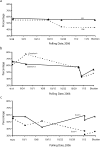Competing initiatives: a new tobacco industry strategy to oppose statewide clean indoor air ballot measures
- PMID: 19150904
- PMCID: PMC2642532
- DOI: 10.2105/AJPH.2008.138461
Competing initiatives: a new tobacco industry strategy to oppose statewide clean indoor air ballot measures
Abstract
To describe how the tobacco and gaming industries opposed clean indoor air voter initiatives in 2006, we analyzed media records and government and other publicly available documents and conducted interviews with knowledgeable individuals. In an attempt to avoid strict "smoke free" regulations pursued by health groups via voter initiatives in Arizona, Ohio, and Nevada, in 2006, the tobacco and gaming industries sponsored competing voter initiatives for alternative laws. Health groups succeeded in defeating the pro-tobacco competing initiatives because they were able to dispel confusion and create a head-to-head competition by associating each campaign with its respective backer and instructing voters to vote "no" on the pro-tobacco initiative in addition to voting "yes" on the health group initiative.
Figures


Similar articles
-
The Duluth clean indoor air ordinance: problems and success in fighting the tobacco industry at the local level in the 21st century.Am J Public Health. 2003 Aug;93(8):1214-21. doi: 10.2105/ajph.93.8.1214. Am J Public Health. 2003. PMID: 12893598 Free PMC article.
-
Changes in air quality and second-hand smoke exposure in hospitality sector businesses after introduction of the English Smoke-free legislation.J Public Health (Oxf). 2008 Dec;30(4):421-8. doi: 10.1093/pubmed/fdn062. Epub 2008 Jul 23. J Public Health (Oxf). 2008. PMID: 18653490
-
Development of a social will for tobacco control index.Am J Health Behav. 2006 Jan-Feb;30(1):15-26. doi: 10.5555/ajhb.2006.30.1.15. Am J Health Behav. 2006. PMID: 16430317
-
Boards of Health as venues for clean indoor air policy making.Am J Public Health. 2002 Feb;92(2):257-65. doi: 10.2105/ajph.92.2.257. Am J Public Health. 2002. PMID: 11818302 Free PMC article. Review.
-
The diffusion and impact of clean indoor air laws.Annu Rev Public Health. 2008;29:171-85. doi: 10.1146/annurev.publhealth.29.020907.090920. Annu Rev Public Health. 2008. PMID: 18348710 Review.
Cited by
-
When tobacco targets direct democracy.J Health Polit Policy Law. 2014 Jun;39(3):537-64. doi: 10.1215/03616878-2682603. Epub 2014 Mar 6. J Health Polit Policy Law. 2014. PMID: 24603083 Free PMC article.
-
Political factors affecting the enactment of state-level clean indoor air laws.Am J Public Health. 2014 Jun;104(6):e92-7. doi: 10.2105/AJPH.2013.301689. Epub 2014 Apr 17. Am J Public Health. 2014. PMID: 24825239 Free PMC article.
-
Defeating JUUL's Effort to Rewrite San Francisco's E-Cigarette Regulations.Am J Public Health. 2021 Mar;111(3):457-464. doi: 10.2105/AJPH.2020.305993. Epub 2021 Jan 21. Am J Public Health. 2021. PMID: 33476232 Free PMC article.
-
The Grassroots of Grass: Cannabis Legalization Ballot Initiative Campaign Contributions and Outcomes, 2004-2016.J Health Polit Policy Law. 2020 Feb 1;45(1):73-109. doi: 10.1215/03616878-7893579. J Health Polit Policy Law. 2020. PMID: 31675092 Free PMC article.
-
Enacting tobacco taxes by direct popular vote in the United States: lessons from 20 years of experience.Tob Control. 2009 Oct;18(5):377-86. doi: 10.1136/tc.2009.029843. Epub 2009 Jun 25. Tob Control. 2009. PMID: 19556615 Free PMC article.
References
-
- Levy DT, Chaloupka F, Gitchell J. The effects of tobacco control policies on smoking rates: a tobacco control scorecard. J Public Health Manag Pract 2004;10:338–353 - PubMed
-
- Henson R, Medina L, St Clair S, Blanke D, Downs L, Jordan J. Clean indoor air: where, why, and how. J Law Med Ethics 2002;30:75–82 - PubMed
-
- Gilbert MD, Levine J. Less can be more: conflicting ballot proposals and the highest vote rule. The Berkeley Electronic Press. 2007. Available at: http://law.bepress.com/cgi/viewcontent.cgi?article=1975&context=alea. Accessed September 11, 2008
-
- Bowler D, Donovan T. Demanding Choices: Opinion, Voting, and Direct Democracy. Ann Arbor: University of Michigan Press; 1998
MeSH terms
Substances
Grants and funding
LinkOut - more resources
Full Text Sources
Medical

